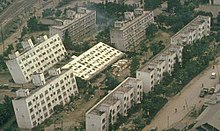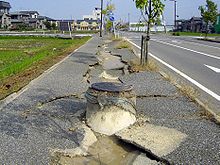Soil liquefaction


Soil liquefaction or liquefaction can occur as a result of strong vibrations of water-saturated, mostly sandy soil layers ( Quickerde ) by an earthquake .
If moist soils are loosely stored and groundwater is near the surface, earthquakes can cause soil liquefaction. Coastal areas with alluvial soil often meet these criteria. Soils with a very even grain structure are predestined, especially sands such as those found in estuary deltas , as well as loess and clay soils. Particularly “young” water-saturated sediments that have only been deposited in the last 10,000-15,000 years can liquefy due to the pressure waves of a high-frequency earthquake near the surface.
Loose soils contain - similar to quicksand - a high proportion of pores. Their particles only touch at a few points of contact. If the pressure wave (dynamic load) of an earthquake increases the pore pressure in the structure of water-saturated soils, the static friction between the grains of sand and thus the shear strength of the soil can drop so much that the soil behaves like a liquid.
Particularly heavily liquefied soil can emerge on the surface in places, including in the form of mud fountains. This reduces the pressure created.
Buildings on liquefied soil can sag unevenly. Underground structures such as sewers that contain voids can be pushed upwards.
To distribute fresh concrete and loosen the air bubbles it contains, vibrators are used, which can locally liquefy even very stiffly mixed concrete.
Earthquakes associated with large-scale soil liquefaction include the Christchurch earthquake ( February 2011 and June 2011), for example, the earthquake in Haiti in 2010 , the Loma Prieta earthquake in San Francisco in 1989 or the devastating Tangshan earthquake in 1976 in China . Soil liquefaction has also been proven for more than 1200 km² in the alluvial land of the Po Valley in northern Italy after the two main quakes on May 20, 2012 (Mw ~ 6.1) and May 29, 2012 (Mw ~ 6.0) as well as the Sulawesi earthquake in 2018 .
Web links
- Helmholtz Knowledge Platform Earth and Environment ESKP
- Knowledge.de: Soil Liquefaction ( Memento of March 8, 2009 in the Internet Archive )
- Video of liquefaction during Niigata Earthquake 1964 Soil liquefaction during the earthquake in Niigata 1964 ( YouTube video, with music, 2010)
- Soil Liquefaction Web Site (English)
- Narrative of strong ground shaking and liquefaction on Harbor Island (south of downtown Seattle) during the Nisqually earthquake ( Memento from February 13, 2008 in the Internet Archive )
Individual evidence
- ↑ Till Fähnders: A monster from a liquid end. In: faz.net, October 3, 2018.